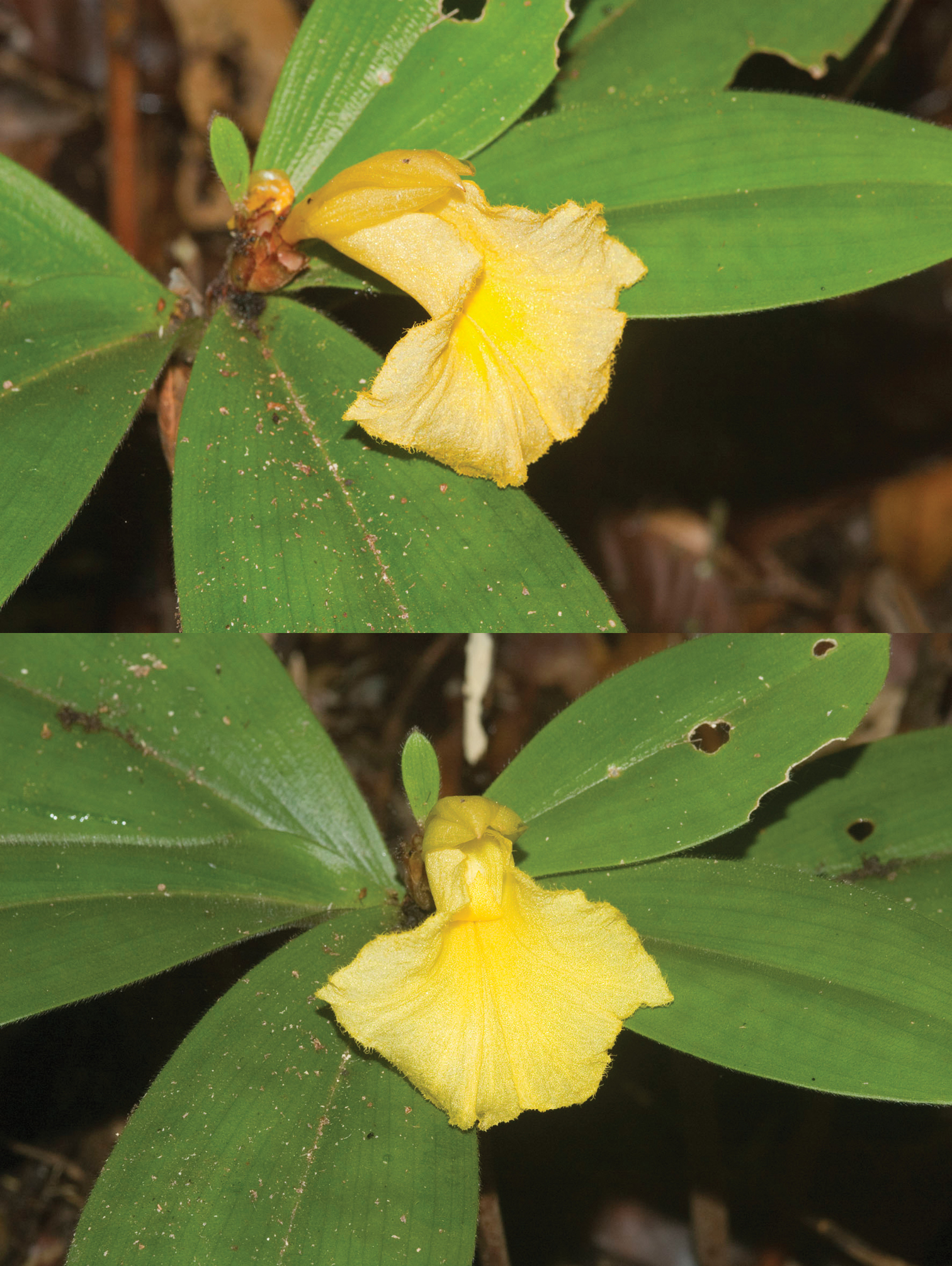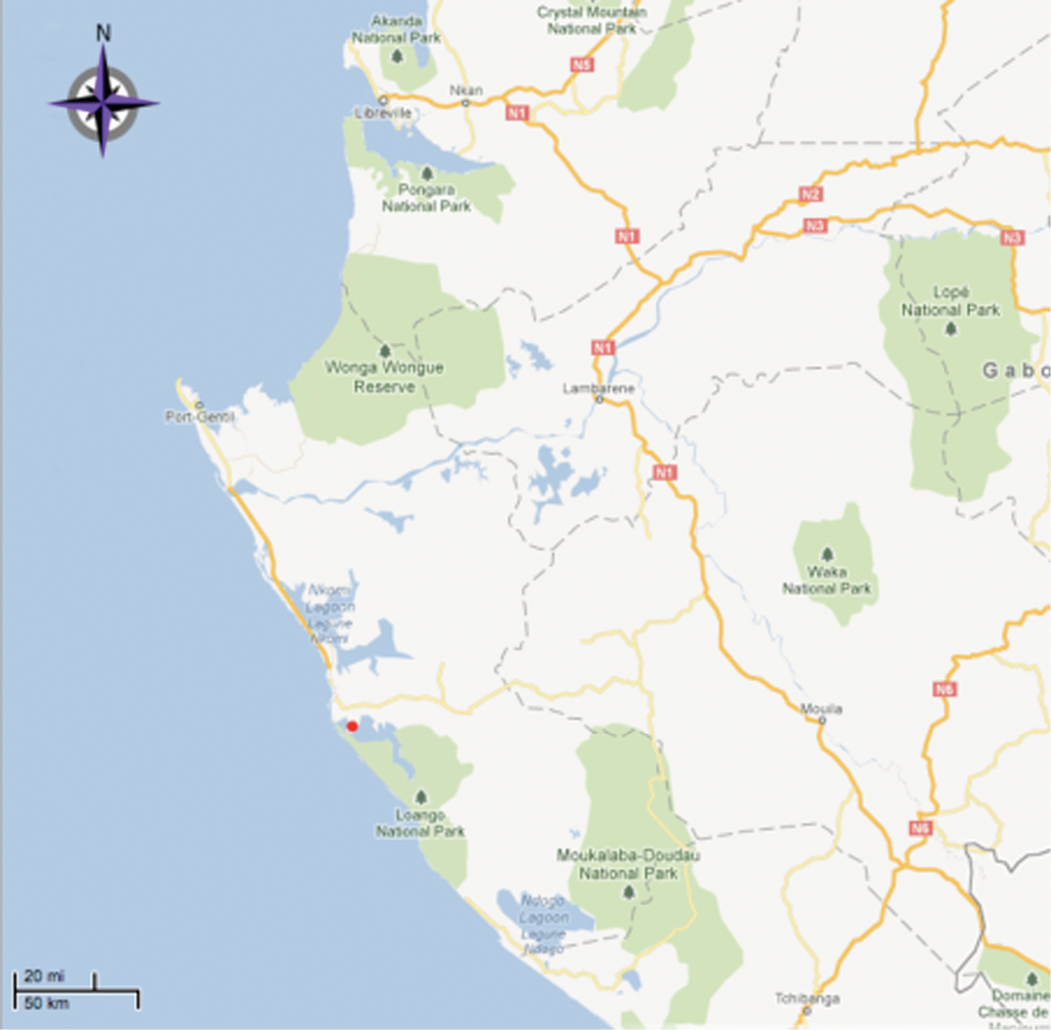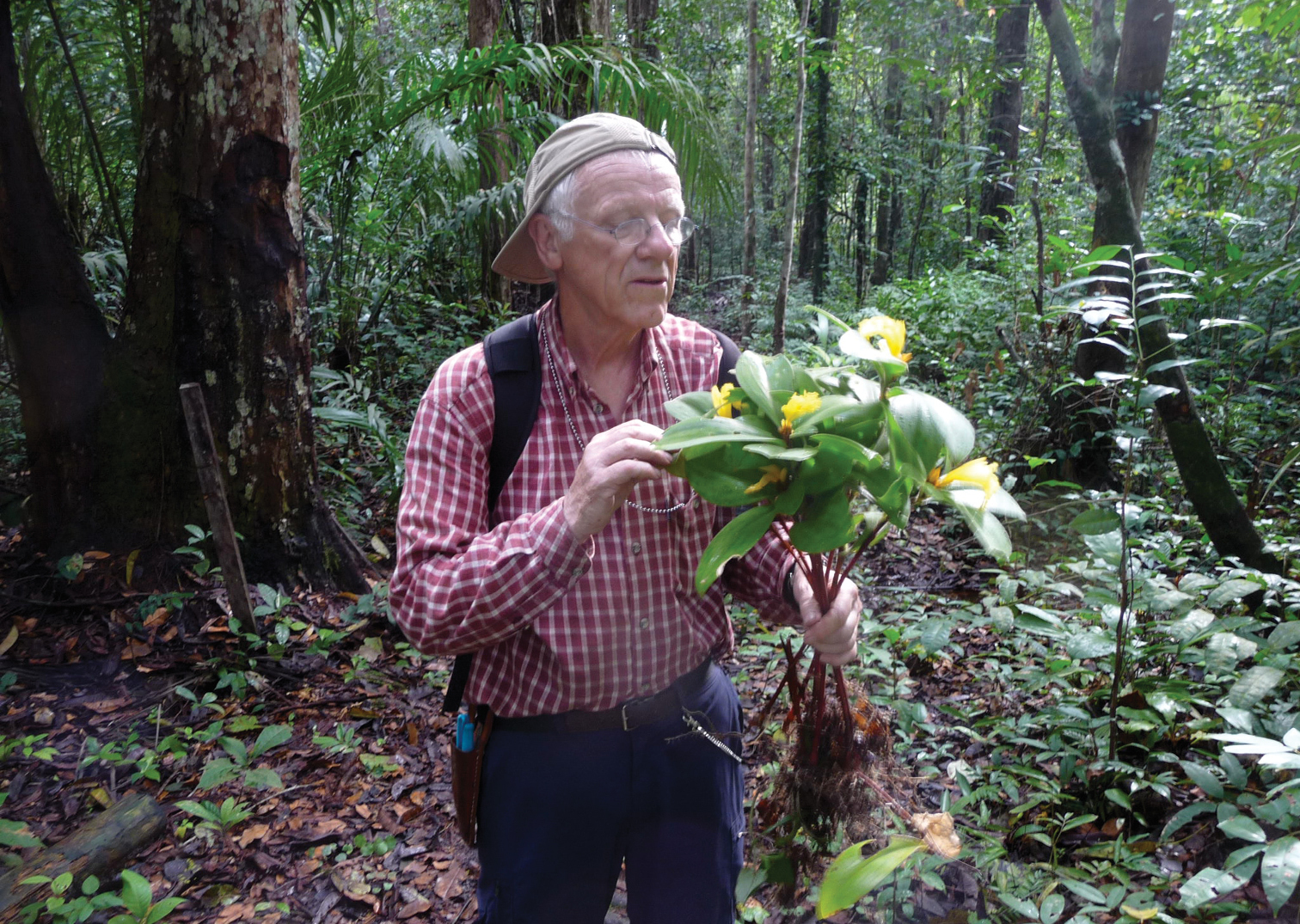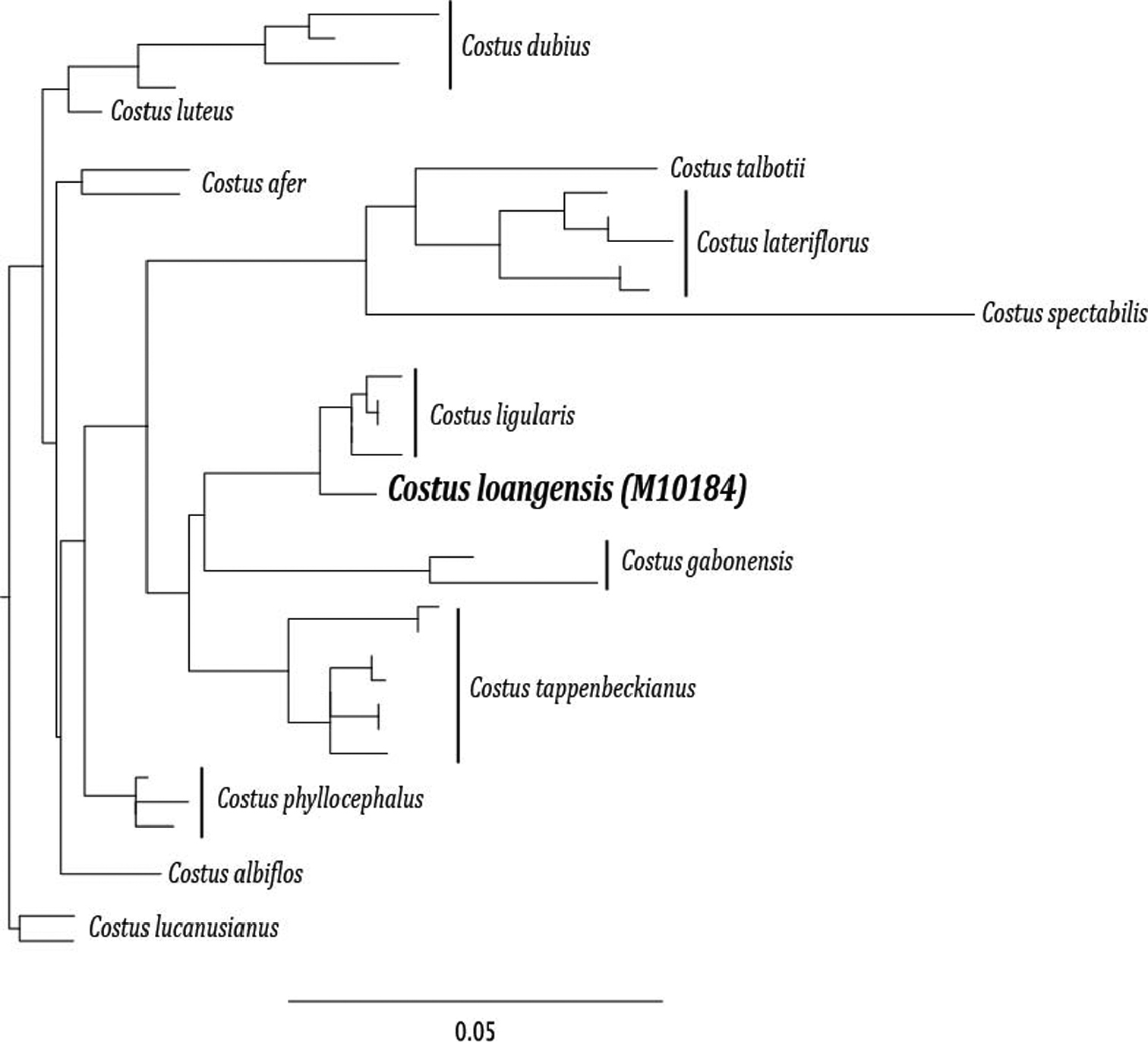






(C) 2012 Hiltje Maas-van de Kamer. This is an open access article distributed under the terms of the Creative Commons Attribution License 3.0 (CC-BY), which permits unrestricted use, distribution, and reproduction in any medium, provided the original author and source are credited.
For reference, use of the paginated PDF or printed version of this article is recommended.
A new species of spiral ginger (Costus: Costaceae) from Gabon, Africa is described. Costus loangensis H. Maas & Maas is found in the coastal region on white sand soils under a tropical rain forest canopy. It is morphologically distinct from all other African species of Costus but shows some similarities in floral form with the savanna-inhabiting Costus spectabilis (Fenzl) K. Schum. and similarities in vegetative form with Costus ligularis Baker. Only one population of the new species is documented. Photographs of the new species are included as is a preliminary phylogeny indicating its position within the African Costaceae.
Africa, Gabon, Costaceae, Costus, Zingiberales, spiral ginger
The plant family Costaceae is pantropical in distribution with its largest genus, Costus L., restricted in distribution to African and New World Tropics. Based on phylogenetic studies, the ancestral distribution of Costus is the African tropics and its current distribution is reflective of a long distance dispersal event from Africa to the neotropics (
In all Costus species, the staminodial labellum, formed by the fusion of five petaloid organs in the stamen whorl, is predominantly responsible for the floral display. The ancestral Costus flower had a broad, open labellum; solid white or yellow in color; with no strong markings indicative of a specific pollination syndrome (
As part of a larger effort to monograph all African species of Costus, the authors recovered a photograph of a Costus flower published in a guide to the Loango National Park (
Costus loangensis (Fig. 1) is a short-stemmed (about 0.5 m tall) plant with few (6–7) leaves and with completely yellow flowers. Stems and leaves are covered with a dense indument of erect to half-appressed hairs. Costus loangensis differs from Costus spectabilis (Fenzl) K.Schum., another short-stemmed yellow-flowered species, by having a well developed aerial stem. Costus spectabilis inhabits savannas and has only 4 leaves that remain strongly pressed to the ground. Costus loangensis differs from Costus ligularis Baker, also a short-stemmed and indumented plant, by the colour of its flowers (Costus ligularis has a pale pink flower) and the length of the calyx (5-7mm in Costus ligularis v. 11–12mm in Costus loangensis) (Table 1).
Photographs of Costus loangensis from the single known population. Photo credit: J.P. Vande weghe.
Use of characters to differentiate Costus loangensis from other African species with similar morphological characters.
| Species | Flower color | Stem height | Bract appendage |
|---|---|---|---|
| Costus loangensis | yellow | 0.5m | No |
| Costus spectabilis | yellow | 0m | No |
| Costus ligularis | pale pink to white | 0.5m | No |
| Costus gabonensis | yellow | 1.5m | Yes, red/brown reflexed |
P.J.M. Maas, F.J. Breteler, C.D. Specht, H. Maas-van de Kamer, R. Niangadouma 10184 (holotype WAG; isotypes K, LBV, MO, UC), Gabon, prov. Ogooué-Maritime: Parc Nacional de Loango, between Lodge and Staff building, 1°54'43.3"S, 9°19'33.6"E, wet forest on white sand, along forest trail, at about sea level, 9 November 2011.
Terrestrial herb, 0.5–0.6 m tall, stems dark brownish red. Leaves: dark olive-green, several (6–7) concentrated at the apex of the stem; sheaths dark red, 0.6–0.8 cm diam.; ligule green, 2-lobed, 15–18 mm long, membranous; petiole 5–6 mm long; sheaths sparsely to rather densely covered with erect to half-appressed hairs ca. 2 mm long, ligule and petiole densely to rather densely so; lamina narrowly elliptic to elliptic, 14–16 by 5–6 cm, densely to rather densely covered with erect to half-appressed hairs 1.5–2 mm long on both sides, zone along midrib sometimes reddish, base attenuate, apex acute. Inflorescence: 3–5-flowered, ovoid, 2 by 1–1.5 cm, terminating the leafy stem; outer side of bracts, bracteoles and calyx densely covered with appressed to half-appressed hairs ca. 0.2 mm long, ovary sparsely so. Flower: 1 per bract; bracts brown to reddish brown, chartaceous, narrowly ovate-triangular to ovate-triangular, 1.7–2 by 0.5–1 cm, callus 2.5–3 mm long; appendages absent; bracteole reddish, boat-shaped, 15–18 mm long, callus 1.5–2 mm long; calyx reddish to greenish, 11–12 mm long, lobes deltate, ca. 2 mm long, callus ca. 1 mm long; corolla yellow, 50–55 mm long, tube 20–25 mm long, lobes narrowly elliptic, 30–35 mm long, outer side rather densely covered with half-appressed hairs ca. 1 mm long particularly near the apex, together forming a hood over the throat opposite the labellum, apex with a callus-like thickening; labellum yellow, horizontally flattened with funnel-shaped base, broadly obovate when spread out, 30–40 by 40–50 mm, margin fimbriate (fimbriae 2–3 mm long); stamen yellow, 25–30 by 7–10 mm, apex reflexed, anther 5–7 mm long; ovary narrowly obovoid, ca. 6 mm long, stigma bilamellate, dorsal appendage 2-lobed. Fruit and seeds not seen.
Gabon (Fig. 2). Only known from the type location.
Map of locality for Costus loangensis. The red dot represents the type locality.
In wet forest, on white sand soil under rain forest canopy (Fig. 3). Elevation just above sea level. Flowering: November; fruiting: unknown.
Costus loangensis habit and habitat, as being studied by co-author P.J.M. Maas. Photo credit: H. Maas-van de Kamer.
Based on a combined 4 molecular marker (CAM, ITS, ETS, rpb2) phylogenetic analysis with taxon sampling that included African species in the genus Costus, Costus loangensis H. Maas & Maas is found to be well supported as sister to a clade of Costus ligularis Baker specimens (Fig. 4). Costus loangensis fits within the general distribution range of Costus ligularis, however no populations of Costus ligularis were found in sympatry. Costus loangensis is restricted in elevation to just above sea level, while Costus ligularis is commonly found 0–600m above sea level throughout low-elevation rain forests in Cameroon and Gabon.
Phylogeny of African Costus species (Table 2) including newly described Costus loangensis. The phylogeny was constructed in PhyML (
List of collections included in phylogeny to place Costus loangensis sp. nov.
| Costus | Costus afer | L87-0185 |
| Costus | Costus afer | M10205 |
| Costus | Costus albiflos | M10411 |
| Costus | Costus dubius | M10206 |
| Costus | Costus dubius | GH89-0918 |
| Costus | Costus aureus | M9302 (vouchered from Burger’s Bush) |
| Costus | Costus lucanusianus | M10000 |
| Costus | Costus lucanusianus | L87-0286 |
| Costus | Costus ligularis | M10329 |
| Costus | Costus ligularis | M10267 |
| Costus | Costus ligularis | BB 1998-0923003 |
| Costus | Costus lateriflorus | M9995 |
| Costus | Costus lateriflorus | M10331 |
| Costus | Costus lateriflorus | GH98-224 |
| Costus | Costus spectabilis | GH96-284 |
| Costus | Costus gabonensis | M10291 |
| Costus | Costus gabonensis | CS02-339 |
| Costus | Costus tappenbeckianus | M10226 |
| Costus | Costus tappenbeckianus | GH94-628 |
| Costus | Costus talbotii | BB 2003-0109009 |
| Costus | Costus phyllocephalus | M10389 |
| Costus | Costus phyllocephalus | L87-0057 |
| Costus | Costus phyllocephalus | BB 2001-0402004 |
L=Lyon Arboretum
M=Maas collection
CS=C. Specht collection
GH=Greenhouse at Smithsonian NMNH
BB=Burger’s Bush
Not recorded. This plant seems to go unnoticed by the local population and has no known uses.
Costus loangensis is named after the place where it was photographed and now has been collected and documented for the first time: near the Loango Lodge, in “Parc Nacional de Loango” in Gabon.
The authors thank Mr. Jean Pierre Vande weghe for his invaluable help in locating the plants, for sending us photographs, and for the permission to use his photographs in this publication. We are highly indebted to the director of Africa’s Eden, Mr. R. Swanborn, for making it possible for the authors to stay in “Parc Nacional de Loango” and to search there for this plant; to Dr. Frans Breteler for helping to organize the field expedition, assistance in collection and identification, and superb logistic and botanical support; to Raul Niangadouma (Herbarium LBV in Libreville, Gabon) for field assistance, guidance and for sharing his extensive knowledge of Gabon’s native flora; and to Dr. Bas Verhage, WWF Gamba Programme Manager in Gabon, for expert advice prior to the trip and logistic support during our fieldwork in and around Loango and the Mandji area of Gabon. HMK and PJMM thank the “Hugo de Vries-fonds” and the “Society for the advancement of research in the tropics” (Treub-Maatschappij) for financial support. CDS acknowledges the National Geographic Society Committee for Research and Exploration (grant #8994-11) for financial support for travel to Gabon and S. Salzman, T. Renner, S. Shen, and K. Yu for producing and analyzing the phylogenetic data presented in this paper.



